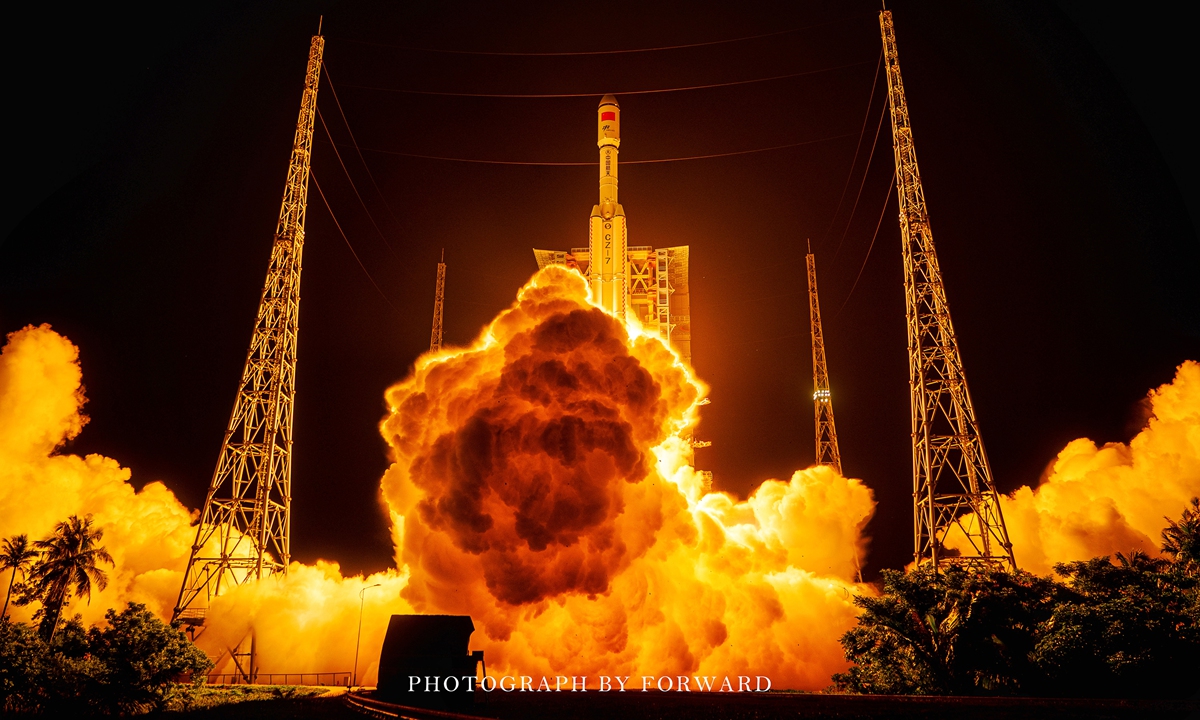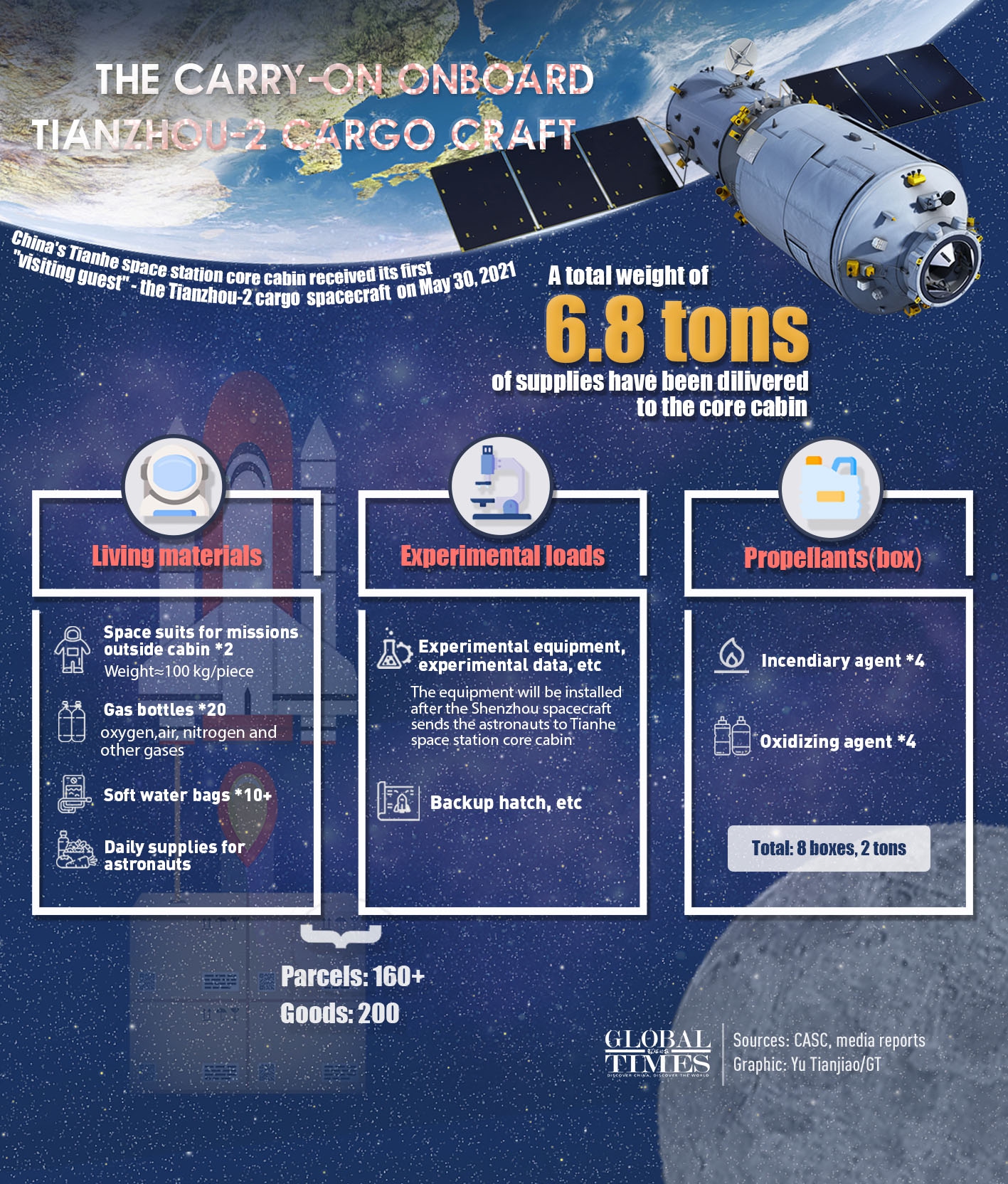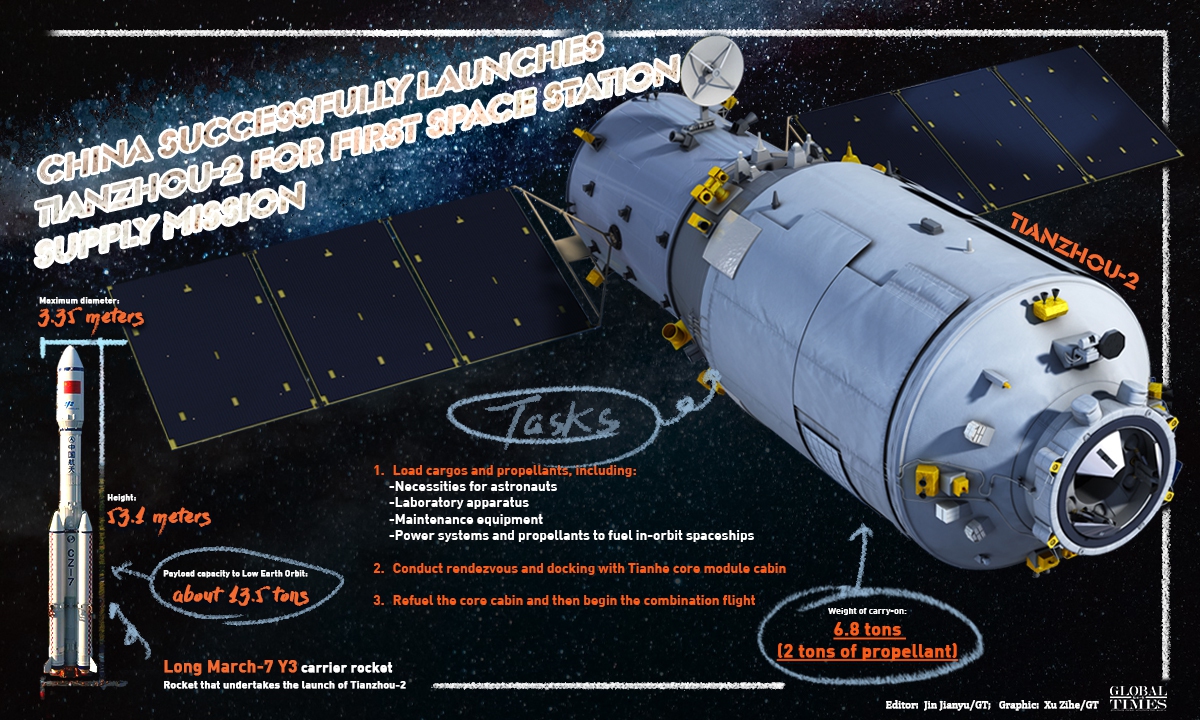
Photo: Guo Wenbin
China has not only successfully launched its Tianzhou-2 cargo spacecraft for the country's first Tianhe space station core cabin supply mission on Saturday, but also tested and performed an ultra-fast yet smooth automatic docking of the cargo ship with the Tianhe module - within only eight hours after launch - early on Sunday, achieving yet another spectacular milestone during the country's recent epic advancements on almost all fronts in the space sector within a month.

The Tianzhou-2 mission seen a substantial improvement in the spacecraft's fast docking capability, will be adopted in the upcoming Shenzhou-12 manned mission, shortening astronauts’ stay on the craft from two days to only six hours: insiders.
The fruitful Tianzhou-2 flight mission came after the launch of the first section of the country's space station, the Tianhe core cabin on April 29, the country's first interplanetary mission Tianwen-1's soft landing on Mars on May 16, and the Zhurong Mars rover embarking on its first journey on the Red Planet on May 22.
Tianzhou-2, dubbed the "
delivery guy" for the space station construction project, conducted a smooth rendezvous and
docking with the Tianhe core cabin around 5 am on Sunday morning, around eight hours after the lift-off of the Long March-7 Y3 carrier rocket from Wenchang spaceport in South China's Hainan Province at 8:55 pm Saturday, China Manned Space Agency (CMSA) said in a statement it sent to the Global Times.
Tianzhou-2 was originally slated to be launched at around 1:30 am on May 20 for a supply run to the space station's core cabin. However,
the launch was scrubbed narrowly in less than two hours ahead of the scheduled launch due to "technical reasons," as the ground command center found a parameter indicating pressure levels returning abnormal data, according to People's Daily.
Space observers saw the postponement as a normal practice in the aerospace industry and said it showed China is not rushing into anything but keeping a steady pace, and is resolute in preventing any potential risks from going to space.
The 10.6-meter-long, 3.35-meter-diameter Tianzhou cargo craft, is the first visitor of the China's space station, and is tasked with refueling the Tianhe space station core cabin for its maintenance in orbit, conducting space scientific experiments, and also shipping living necessities for astronauts on future crewed mission at the space station, Global Times learned from the project contractors.
As first spaceship launched in the space station construction phase, Tianzhou-2 weighed 13.5 tons at launch, and is capable of sending a payload of 6.9 tons for supply missions. Its in-orbit service is at least one year, said Feng Yong, commander-in-chief of the Tianzhou-2 mission from the project contractor China Academy of Space Technology (CAST).
There were 6.8 tons of supplies onboard the Tianzhou-2, including some 160 parcels of goods and two tons of propellants, according to the CAST.
The carry-on also includes two space suits for the astronauts' outside-cabin activities, which weighs more than 100 kilograms each, CAST disclosed.
"The load to total mass ratio is over 50 percent, indicating its world leading capacity." Lei Jianyu, deputy director designer of the Tianzhou-2 spacecraft, said that there are only two cargo spaceships in active service in the world that are capable of sending payloads of more than five tons, and Tianzhou is one of them, and has the "world class capability."
Ground logistics technology has also been adopted for the spacecraft. For example, astronauts can obtain the location and further information of specific goods by scanning a QR code, and the inventory information is recorded in a dynamic manner so that astronauts can keep track of changes of goods, Yang Sheng, the cargo spacecraft system's chief designer, disclosed.

China successfully launches Tianzhou-2 for first space station supply mission Infographic: Xu Zihe/GT
Fast and steadyThe Saturday/Sunday mission also witnessed a substantial improvement in the Tianzhou spacecraft's fast docking capability. Compared to the Tianzhou-1's rendezvous and docking with Tiangong-2 in 2017, which took about two days, it took a mere eight hours to achieve the feat.
The Tianzhou-2 adopted a new long-distance guiding technology, as it was able to use the location information provided by the country's BeiDou Navigation Satellites System, or BDS, to automatically navigate itself for the rendezvous and docking with the space station, whereas the Tianzhou-1 version needed artificial assistance to lead the craft to approach Tiangong-2 for the move.
In an ideal situation, the time for the rendezvous and docking of Tianzhou-2 would be reduced to some four hours, CAST announced.
In the event of an emergency, this kind of fast rendezvous and docking technology will also facilitate quick responses by providing all kinds of urgently needed materials to the space station and rescue the trapped astronauts, according to the academy.
Wang Zhonggui, deputy director of the China's manned space project, disclosed that such success would mark that we have achieved breakthrough in fast docking technology, so that it will become a new normal for future missions, be it cargo or manned spacecraft missions.
Pang Zhihao, a Beijing-based senior space expert, hailed that such breakthrough technology would tremendously benefit crewed missions, as it would save astronauts from longer stay in the narrow space onboard the spacecraft, making their space travel cozier.
It would also save the resources with the ground command center, Pang told the Global Times on Sunday.
Another benefit brought with the fast docking capability is that more samples for biological experiments can now be brought into space, as they would normally require higher standards of environment that could only be met in the space station and need to be delivered in rather short time period, Pang said.
According to Wang, the upcoming Shenzhou-12 manned spacecraft will also adopt such fast technology, which is good news for astronauts onboard, shortening their stay on the craft from two days to only six hours.
Ready for human flightThe three astronauts who will take the Shenzhou-12 manned spacecraft to China's Tianhe space station core cabin in June are now under Level-2 quarantine, with all related work having entered a final sprint stage, Yang Liwei, director of the China Manned Space Engineering Office and the country's first astronaut revealed.
Yang, who went into space in the Shenzhou-5 craft on October 15, 2003, made the remarks during an interview with state broadcaster China Central Television (CCTV) on Saturday, following the successful launch of the Tianzhou-2 cargo craft earlier in the day.
According to Yang, the three astronauts of the Shenzhou-12 mission, who were selected from China's first and second batch of astronauts, will stay in space for three months, during which they will conduct tasks including repair and maintenance, appliance switch and scientific operation of payloads.
Although there will not be any female astronauts in the upcoming Shenzhou-12 crewed mission, they will basically participate in every following flight mission, Yang disclosed.
The three astronauts will take on command and engineer roles, and all of them possess the capability of working outside the cabin, he said.
With the successful launch of the Tianzhou-2 cargo ship Saturday, China has completed its first two launch missions out of the total 11 of the intensive space station construction phase, scheduled from April 29, 2021 to 2022. Three will be for modules, four for cargo spaceships and four for manned spaceships.
Four flight crews have been selected from the first and second batch of astronauts for the four Shenzhou missions. Astronauts will conduct multiple tasks outside the cabin, carrying out repair and maintenance on the spacecraft, and other construction missions, said Yang. "Astronauts coming out of the cabin will become a new routine, and the duration of such activities will be greatly expanded."
China's space station has also been equipped with robotic arms that can be stretched to 15 meters long, which will also play a vital role in building the space station in orbit, Zhou Jianping, chief designer of China's manned space engineering project, said previously.
Astronauts will team up with these robotic arms to make in-orbit space station construction and maintenance possible, Yang noted.






